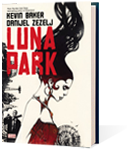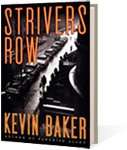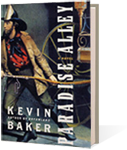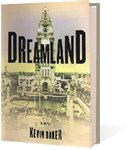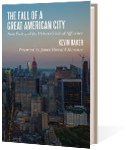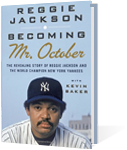By Kevin Baker
Huddled masses approaching America at at the turn of the century saw first not the Statue of Liberty, nor the Brooklyn Bridge, nor even the breathtaking new skyscrapers, pushing their way up past the church steeples. What they saw was a wholly different phenomenon: The City of Fire—the vast new set of wonders sprawled along the sands on the southern tip of Brooklyn.
Like the bush Moses encountered on Mount Horeb, Coney Island burned but was not consumed. It was made up of three great amusement parks, Steeplechase, and Luna Park, and Dreamland; each of them adorned with that other new phenomenon of the age, the electric lightbulb, so that when the sun went down the whole island looked as if it were strung with frozen pearls of fire, spinning and plunging and whirling in place.
Even in during the day, Coney Island circa 1910 was a stunning place. Luna Park was the most beautiful of the three great parks, though the other two were not far behind. Just inside its main gate, with its two crosses plunged into a red heart in some transplanted bit of Catholic iconography, lay a fairy-tale ramble of minarets and onion domes, turrets and colonnades, lagoons and trellises. It was a jumble of every style of architecture the world had ever seen; a sort of Dr. Seuss world, all painted a glowing orange and white and gold, and pieced together by one Frederick Thompson, the moody, alcoholic Frank Lloyd Wright of the American amusement.
An amusement—there was the holy hell of it. What other city, what other nation, had ever thrown so much time and money and care into a public amusement?
Albeit one that Americans of today would find very disconcerting. The old Coney Island today would be a field day for personal injury lawyers. Many of its amusements were designed to help men and women meet by throwing them together—hard. Others simply reflected the rather rough and insensitive humor of the day. Visitors climbing off the Steeplechase ride—a relatively mild jaunt on mechanical horses, over a mile-and-a-quarter track—were surprised by an obstacle course that included a dwarf in a harlequin suit, taking a swing at their legs with a cattle prod—and all for the amusement of their fellow New Yorkers, watching and laughing from a neighboring bleacher.
Still other exhibitions reflected the time’s wider sense of entertainment. There was a hall where patrons could go to watch the country’s first incubator babies struggling for life, and a permanent, year-round village, filled with dwarves and midgets, and African tribesmen living in actual grass huts. There were huge stages where one could go to watch the latest global disasters, hurricanes and floods, volcanoes and wars.
The old Coney Island was the product of a time when Americans still liked their entertainment with a strong undertaste of danger. A conductor-driven rollercoaster called the Rough Rider once went right through the retaining walls, killing four passengers. There was a seemy underside of the boardwalk, including Coney’s own, miniature “Bowery,” and a rundown hotel—in the shape of a giant elephant—that served as a local whorehouse.
But Coney was, in the end, more than a Sunday outing. It was a place where immigrants were both literally assimilated in the roiling, holiday mobs, but also where they went to see the whole pageant of their lives played out before them. Small wonder that one of the most popular exhibits was a fake tenement that was set on fire and put out by fake firemen, every day—for a viewing public that itself lived in constant fear of such an event.
That Coney is long gone. Dreamland burned down in 1911, Luna Park in 1946, and they finally closed Steeplechase in 1964. Little more than a closed parachute jump and a ragged old coaster remain. But Coney lives on, imitated by world’s fairs in Chicago in 1933, New York in 1939-40 and 1964-65; in the Disney theme park; in the names of old, deteriorating amusement parks on the outskirts of cities throughout the United States. None of them, though, have ever compared to that world of frozen fire, burning along the sands of Long Island.
American Greats Edited by Robert A. Wilson & Stanley Marcus
Public Affairs Press, a member of the Perseus Group

